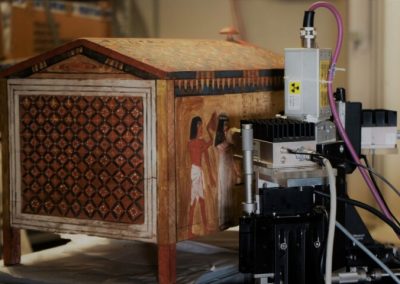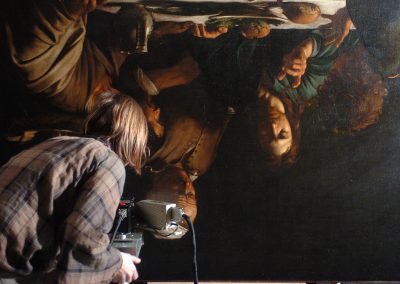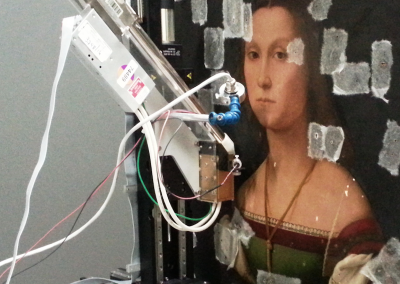How to access
How to access
Do you work in Heritage Science?
E-RIHS.it offers the opportunity to access the most sophisticated scientific instruments and take advantage of the most innovative methodologies developed and distributed throughout the national territory for a better interpretation, knowledge, conservation and restoration of the cultural heritage.
E-RIHS.it is the only national network that embraces scientific excellence in cultural heritage: it provides analytical methods and cutting-edge skills developed by its researchers. It offers free access to laboratories and equipment.
E-RIHS.it receives the financial support of the Ministry of the University and Research (MUR). The goal of the Italian node is to promote and support the progress of scientific research both for the knowledge and conservation of Cultural Heritage. Archaeologists, conservators, art historians, restorers, scholars of cultural heritage can request the intervention of the researchers and tools of the mobile laboratories of E-RIHS.it for the study of works of art, monuments, and archaeological sites on the Italian territory, by applying to a call launched every year by E-RIHS.it.
Le proposte di progetto possono essere presentate esclusivamente da proponenti affiliati ad istituzioni e enti italiani. Tuttavia, il bene o il sito possono essere situati anche all’estero. E-RIHS.it si riserva di finanziare totalmente o parzialmente la campagna in base al budget di spesa, indipendentemente dalla valutazione scientifica.
The Italian node of E-RIHS respects the principles expressed in the European Charter for Access to Research Infrastructures
Call for access
Through an annual call, E-RIHS.it collects and selects, based on scientific quality, research projects for the study of historical, artistic and archaeological, movable and immovable assets, based on a non-invasive in-situ approach.
Each proposer can submit only one project per call in their name.
The proponents of the selected projects have free access to non-invasive portable instruments (point spectroscopic techniques, imaging and geophysics, remote sensing and digitization) to study works of art, monuments and archaeological sites in Italy.
The research projects are selected by a panel of expert reviewers external to the infrastructure.
HOW TO APPLY
The application form must be completed in English and can be sent annually by e-mail to the MOLAB helpdesk (e-rihs.ispc@ispc.cnr.it) by the deadline indicated in the call.
The subject of the e-mail must contain the text "Access request for + Project acronym + Surname of the responsible for the research project".
The application form must be sent by September 30, 2024.
The MOLAB helpdesk can be consulted for any doubt or need for further information when completing the access application.
Click HERE to access the techniques offered by the mobile laboratories to come up with your scientific proposal.
DOWNLOAD HERE the application form
FINANCIAL SUPPORT
Free access to ERIHS facilities is on a competitive basis. Italian scholars, researchers and specialists working in the Cultural Heritage field and belonging to public institutions (Research Bodies, Universities, Superintendencies of Museums) and Italian cultural and creative companies can participate in the call. The cultural assets subject of the proposals must be publicly owned.
The MOLAB access grant includes:
- Transport and travel insurance for all instruments;
- Travel and accommodation of the MOLAB staff;
- Technological and scientific support for the development of research projects.
Users are responsible for:
- Providing insurance for the work of art/object and their staff for the duration of the MOLAB campaign
- providing specific logistics (scaffolding, health and safety requirements) to exploit MOLAB equipment in the best conditions and safety.
PERMITS
Qualsiasi tipologia di permesso necessario per lo svolgimento della campagna diagnostica, relativo iter burocratico ed eventuale, relativa quota è a carico dell’utente.
EVALUATION
After the submission of the applications, the ERIHS helpdesk and the coordinators of the platforms will verify their suitability. After this first check, the proposals are evaluated:
From a technical point of view. The evaluation is performed by the scientist(s) responsible for the requested instruments. It aims to determine the technical feasibility of the analysis and the consistency of the requested access dates. In case a multi-analysis proposal has been submitted by the user group leader, its feasibility will be verified by all scientists responsible for the instruments. If the proposal is feasible for all tools, it will be sent to the Peer Review Panel (PRP) for scientific evaluation. If the proposal for one or more instruments is considered unfeasible, the user group manager will receive an email informing of any changes.
From a scientific point of view. This evaluation is performed by a group of independent international experts (PRPs), recognized for their experience in conservation and scientific studies on cultural heritage. Project proposals will be selected on a competitive basis. Criteria include:
– Scientific excellence
– Inter/multidisciplinarity
– Exploitation plan and dissemination of results
– Competence of the user group
Applications should aim at increasing scientific production (qualitatively and quantitatively), optimizing the use of local skills of ongoing research activities and structures, and promoting long-lasting scientific cooperation at the national (and international) level.
The Peer Review Panel evaluates the scientific content of the project and classifies the proposals.
At the end of the evaluation (which takes about 3-4 months), the User Helpdesk will send an email to the user group manager communicating the result.



